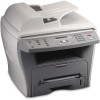Lexmark X215 User's Guide - Page 22
Guidelines for paper and specialty media, Selecting print materials - laser printer
 |
View all Lexmark X215 manuals
Add to My Manuals
Save this manual to your list of manuals |
Page 22 highlights
Size, input sources and capacities Input source/capacity1 Size (mm/in.) Paper tray Card stock2 No/0 A6 card (105 x 148/4.13 x 5.88) Postcard (101.6 x 152.4/4 x 6) 1 Maximum capacity may be reduced depending on paper thickness. 2 This media must be fed one sheet at a time through the manual bypass. Manual bypass Yes/1 Guidelines for paper and specialty media When selecting or loading paper, envelopes, transparencies, or other specialty media, keep these guidelines in mind: • Attempting to print on damp, curled, wrinkled, or torn paper can cause paper jams and poor print quality. • Use only high quality, copier grade paper. Avoid paper with embossed lettering, perforations, or texture that is too smooth or too rough. • Store paper in its ream wrapper until ready to use. Place cartons on pallets or shelves, not on the floor. Do not place heavy objects on top of the paper, whether it is packaged or loose. Keep it away from moisture, or other conditions that could cause it to wrinkle or curl. • During storage, you should use moisture-proof wrap, such as a plastic container or bag, to prevent dust and moisture from contaminating your paper. • Always use paper and other materials that conform with those listed in "Selecting print materials" on page 21. • Use only well-constructed envelopes with sharp, well creased folds. • Do not use envelopes with clasps and snaps. • Do not use envelopes with windows, coated lining, self-adhesive seals, or other synthetic materials. • Do not use damaged or poorly made envelopes. • Load specialty media one sheet at a time. • Use only materials recommended for use with laser printers. • To prevent specialty media, such as transparencies and label sheets, from sticking together, remove each sheet from the output tray as it is printed. • Place transparencies on a flat surface after removing them from the machine. • Do not leave transparencies in the paper tray for long periods of time. Dust and dirt may accumulate on the film, resulting in spotty printing. • To avoid smudging caused by fingerprints, handle transparencies and coated paper carefully. Selecting print materials 22















